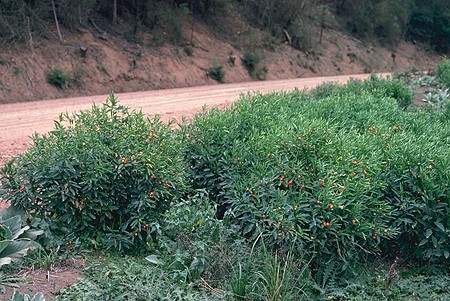
Synonymy
* Solanum pseudocapsicum L., Sp. Pl. 1: 184 (1753)
T: Madeira; lecto: LINN 248.4, (microfiche AD), fide Schönbeck-Temesy in Rechinger (ed.), Fl. Iranica 100 : 6 (1972). See the Linnaean Plant Name Typification Project.
Images from a specimen in Linnaeus's Herbarium in the Swedish Museum of Natural History (S-LINN) can be seen at http://linnaeus.nrm.se/botany/fbo/s/solan/solapse.html.en
The name S. capsicastrum Link ex Schau has been used in Queensland for a form of this species with considerably more pubescence than the common cultivated and feral forms. The hairs are somewhat tufted, branched or dendritic and not truly stellate. If it is desired to distinguish it the name S. pseudocapsicum var. diflorum (Vellozo)Bitter is available of which S. capsicastrum is considered a synonym. http://www.epa.qld.gov.au/publications?id=499
Description
Shrub to 2 m, green, glabrous or sparsely pubescent on young twigs and new growth; prickles absent.
Leaves oblong-lanceolate; lamina 4-10 cm long, 1-3 cm wide, concolorous, slightly undulate; petiole 5-15 mm long.
Inflorescence short, 1-several-flowered; peduncle absent or up to 1 cm long; pedicels c. 1 cm long. Calyx 4-5 mm long; lobes narrowly triangular, 2-3 mm long. Corolla deeply stellate, 10-15 mm diam., white. Anthers 2-3 mm long.
Berry globular, 10-15 mm diam., bright orange-red. Seeds 3-4 mm long, pale buff or yellow, the margin thickened. n=12.
Distribution and ecology
Widespread weed in tropical regions of many countries. Common decorative shrub, naturalised chiefly in eastern Australia from south-eastern Qld to Vic.; also present in S.A. and W.A.
Common in disturbed, wet areas.
Common name
Madeira Winter Cherry, Jerusalem Cherry.
Relationships
A member of subgenus Solanum which includes the "nigrum" group and is typefied by the members being small shrubs with umbelliform inflorescenses. S. spirale and S. pseudocapsicum are the only representatives of sect. Geminata which occur in Australia; while both have yellow-orange berries they are not closely related to each other and can be distinguished by the deflexed fruiting pedicels of S. spirale, these erect in S. pseudocapsicum (Knapp 2002).
Notes
This species has a long history of cultivation and many cultivars varying in plant form and size, fruit size and colour are available. Knapp (2002) notes that the species is widespread and very variable with respect to hair covering but cultivated forms are generally completely glabrous.
Selected specimens
W.A.: Bencubbin, 1968, G.M. Sachse (PERTH). S.A.: near Port Lincoln, C.R. Alcock 2681 (AD: 2 specimens, CANB). Qld: Mt Glorious, V.K. Moriarty 871 (BRI). N.S.W: Thirroul, 1 May 1957, E.F. Constable (NSW). Vic.: Mallacoota Inlet, A.C. Beauglehole 32963 & E.W. Finck (MEL).
From the web
Further information and images of S. pseudocapsicum in NSW can be seen on the PlantNET site and also on their Ecology of Cumberland Plain Woodland site.
A fact sheet for this species can be downloaded from the SA eFlora site.
A photograph of this species by Hugh & Nan Nicholson can be seen on the Terania Rainforest Publishing Photo Library site and the North West Weeds site documenting weeds of the Gwydir and Inverell shires in NSW has an image showing the foliage and fruits of this species .
A line drawing of S. pseudocapsicum can be downloaded from www.anbg.gov.au/poison-plants/poison-PDFs/Solanum-pseudocapsicum.pdf
See the Pacific Island Ecosystems at Risk (PIER) site for a fact sheet and images.
The United States Department of Agriculture Germplasm Resources Information Network (GRIN) has numerous links for this species.
Further information, images and links for this species can be found on the Solanaceae Source site.
There are numerous images of this species on the web because of its use in cultivation - you can do a search through Google Images, but be aware that not all plants are necessarily identified correctly.




